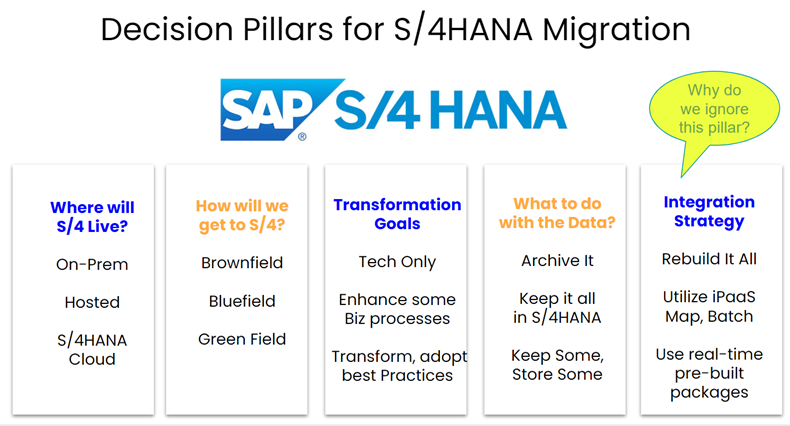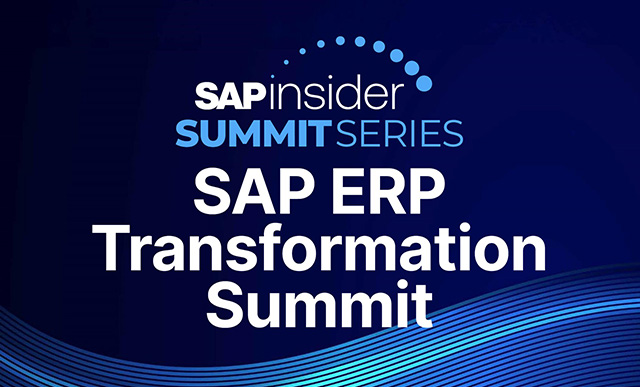Integration Should Be a Pillar of Your SAP S/4HANA Migration Strategy
SAP S/4HANA Pillars | Why Are Integrations Tricky? | Does Real-Time Really Matter?
Hello, my SAP friends,
Well, it’s time. It is officially time to start our
SAP S/4HANA migration planning. I know that migrating is on your radar—and whether you are going to migrate today, in six months, or in 36, the time has come and 2027 is going to be here before we all know it.
I am hoping you are investing time to discover the true benefits of SAP S/4HANA, and there are many, but that discussion is for another day. Today, I am going to share my thoughts about why integration is the most difficult, riskiest, and most challenging part of your S/4HANA migration. While the “How are we going to handle all our integrations?” thought is keeping us up at night, I’ll bet you are not even really planning for it yet.
The discussion for part one of this series talks about the migration pillars to plan for including those fun integrations, why we kind of forget or ignore integration when it should be a critical part of our planning, and why real-time is the difference-maker for your company today.
S/4HANA Migration Pillars
When planning for SAP S/4HANA migrations, there are many decisions to make.

When migrating to SAP S/4HANA, the areas above are the Key Decision pillars that we need to work through to determine the
right choices for our upgrade journey. From talking with so many of you architecting your migration plan, you are deciding where S/4HANA will reside, what path to take to get to S/4, what business value you will deliver, or whether this be a purely technical upgrade. The never-ending decision of how to manage and what to do with
all that data—the struggle is real and ongoing even before thinking about upgrading. All of these are major decision points that can affect the successful outcome of your S/4HANA initiative.
S/4HANA migrations have a lot of pieces to the puzzle: on-prem/cloud, brown, blue, green, hosted or not, technical, or functional or both, do it in-house or get an SI (Systems Integrator), and timing are all considerations you are thinking about as you and the team plan your journey. But integration—something we all do all day, every day—is also a huge branch on the decision tree.
If I asked each of you which way you are leaning—on-prem, hosted, or Cloud—or what new business initiatives you are looking at when you upgrade, I am sure you have ideas on which way you are leaning for each of these pillars. But I am curious—what would your answer be if asked what is the plan to upgrade all your integrations? Are you going to build it all over again, or are you looking at a new toolset to upskill your integration team? Or are you actively looking for prebuilt integration packages to streamline your integration tasks now and in the future? If you have an answer to this question, you are definitely in the minority.
While we know all the other pillars pretty well—the integration-planning pillar gets left out of the discussion, but why? Because we know how to do it—we have done it for years. We have our
ABAP developers who have learned how to map SAP to the middleware layer, and we likely have front-end developers who know how to store the SAP mapped data in our third-party applications.
We have our SAP business analyst teams—they know how to fix and resolve errors when the data does not land in SAP correctly and is stuck in the queues. Our SAP Basis folks have spent years learning how to monitor, manage, tune, and troubleshoot whatever middleware we are using.
This is part of their daily workload, so while it is not an easy task to map, batch, and code integrations, it gets left out of the planning process as you go to S/4HANA. “Let’s just do it the way we always have.” Even though it is not value-added work, it does not align with agile processes, nor does it enable us to drive value to the business quickly. But we are used to it, so let’s just—
ugh—do it this way again.
Why is integration still so difficult in our modern world?

While many of our technologies have evolved since I implemented my first SAP integration back in 2012, integration technology has not evolved much. The big innovations since that time, of course, include moving apps, systems and tech to the Cloud, amazing advancements in artificial intelligence, the speed at which we can compute and, of course, the SAP HANA database platform for advanced in-memory computing.
Our phones know where we are; they can always converse with us and know what we want to buy just by hearing our voice. The list of technological advancements is long, but I am always intrigued why integration has not evolved at the same pace.
See if this story sounds familiar. Ten years ago, we were brand new to SAP PI, and our challenge was to build a robust integration from SAP ECC 6.0 through SAP PI to a third-party application for workforce scheduling. I was the Basis admin, and we had rockstar ABAPers to code and map from ECC into PI. We had workforce scheduling rockstars who coded and mapped the SAP data in the workforce app, and we all learned together.
We were proud of ourselves—we had developed integrations and after much tuning, testing, and administration, it worked well and was innovative and cool back in 2012. When you think about how you and your company tackle current challenges, is it much different today, in 2022?
From what I see in the ecosystem, it really is not, and in fact is eerily similar to what we do today in traditional middleware. Sure, we have more options for standard SAP APIs, and they are more plentiful and rich than the ones we had back then, and even currently for ECC—less coding and mapping, but many are centered around SAP S/4HANA, and most are still, just not real-time.
Does Real-Time Really Matter?
Why, yes. Yes, it does
Okay sure, I bet you can agree with me that having real-time data in many scenarios is optimal, but how to achieve real-time comes with many questions. How in the world do we build that type of integration? And even if we figured out the code to enable real-time, then how do we justify the cost, resources, and assumed risk to do so?
Great thoughts. So, now I want to bring it back to the most important point—
why does real-time matter? Because we need our customers and want to give them valuable user experiences! We sell a product or a service, and our customers need accurate and live data to make an informed decision as to why to buy your product or service, instead of buying from your competitor.
Our internal customers—our sales reps, our service agents, our tech workers—also need that same information. They need to know how much the consumer is going to buy, whether it is available to be shipped, and at what price. And not just
any price; what is
their SAP customer–specific price? This is why real-time really matters.
Let’s walk through a real-life example.
Your company, The Best Yard Equipment Company, manufactures home yard equipment, and your distributor, Home Equipment Distribution, needs to order lawn mowers for several local hardware stores in the Midwest region. The Home Equipment Distribution buyer, Elinor, logs onto The Best Yard Equipment Company portal and peruses the newest models. She is planning to buy a variety of lawn mowers for spring in different volumes and models depending on the store. It is Friday afternoon and the end of the month, so she wants to get this order placed before leaving for the weekend.
But wait—Elinor notices right away that the portal only displays a list price for each mower. She knows as a preferred distributor, Home Equipment Distribution has negotiated pricing and volume discounts. She also sees there is a new promotion running if she buys by the end of the month. But because different stores have unique needs and buying dollars, she cannot take advantage of the promotion because there is no visibility on stock levels, nor can she view her accurate SAP-specific pricing.

Bummer! Elinor is now going to have to call your sales team or customer service—someone to find out the right price and inventory availability so she can decide how much to buy for each store. But it is late on Friday, and no one is picking up the phone. So, now she will have to wait until Monday to place that order. And that end-of-the-month promo pricing? That’s gone, too. Not what any of us would call an amazing user experience.
Well, Elinor is a resourceful buyer and needs to get this order placed today, so she logs into The World’s Greatest Yard Equipment Company, your competitor’s portal, to see what buying options they are offering. Wow! She is perusing some high-end lawn mowers, and when she clicks on a preferred mower, she sees her accurate, negotiated SAP pricing on this mower. The volume pricing discounts are also displayed, and super, there are 50 mowers that can be shipped by next Friday.
She puts these items in her cart and continues her enjoyable shopping experience, filling her cart in minutes. Because the portal is integrated in real-time with SAP data, she can also split her cart to ship to various Ship-To Partner addresses live out of SAP.
Her order is placed, and as The World’s Greatest Yard Equipment Company also has a month-end promo running, she saves even more. With a smile on her face, Elinor feels like a hero and will be a World’s Greatest Yard Equipment Company buyer for life.

Obviously, this is not just a story about Elinor saving some money, which of course she is for her company, but it’s also a story about true digital transformation. It is a story about enabling and empowering our customers to do business with us in the way
they want to. A way for them to also enjoy purchasing our services or products from us—and delivering an amazing user experience at the same time. These are the reasons
why real-time SAP data, specifically, matters for you and your company. Real-time is achievable, so ask and expect real-time to ensure that your SAP S/4HANA migration is a success.
I hope you enjoyed the first installment of this four-part series around key planning concepts for your SAP S/4HANA migration, specifically for integrations. As you can see, these concepts are not only about IT and solutions, but also about successful business outcomes to help you guide your company to success.
In each installment, I will share a new story that exemplifies why having real-time data is so powerful and critical for business success. Looking forward to hearing your thoughts!
Best, Ann
 When migrating to SAP S/4HANA, the areas above are the Key Decision pillars that we need to work through to determine the
When migrating to SAP S/4HANA, the areas above are the Key Decision pillars that we need to work through to determine the  While many of our technologies have evolved since I implemented my first SAP integration back in 2012, integration technology has not evolved much. The big innovations since that time, of course, include moving apps, systems and tech to the Cloud, amazing advancements in artificial intelligence, the speed at which we can compute and, of course, the SAP HANA database platform for advanced in-memory computing.
Our phones know where we are; they can always converse with us and know what we want to buy just by hearing our voice. The list of technological advancements is long, but I am always intrigued why integration has not evolved at the same pace.
See if this story sounds familiar. Ten years ago, we were brand new to SAP PI, and our challenge was to build a robust integration from SAP ECC 6.0 through SAP PI to a third-party application for workforce scheduling. I was the Basis admin, and we had rockstar ABAPers to code and map from ECC into PI. We had workforce scheduling rockstars who coded and mapped the SAP data in the workforce app, and we all learned together.
We were proud of ourselves—we had developed integrations and after much tuning, testing, and administration, it worked well and was innovative and cool back in 2012. When you think about how you and your company tackle current challenges, is it much different today, in 2022?
From what I see in the ecosystem, it really is not, and in fact is eerily similar to what we do today in traditional middleware. Sure, we have more options for standard SAP APIs, and they are more plentiful and rich than the ones we had back then, and even currently for ECC—less coding and mapping, but many are centered around SAP S/4HANA, and most are still, just not real-time.
While many of our technologies have evolved since I implemented my first SAP integration back in 2012, integration technology has not evolved much. The big innovations since that time, of course, include moving apps, systems and tech to the Cloud, amazing advancements in artificial intelligence, the speed at which we can compute and, of course, the SAP HANA database platform for advanced in-memory computing.
Our phones know where we are; they can always converse with us and know what we want to buy just by hearing our voice. The list of technological advancements is long, but I am always intrigued why integration has not evolved at the same pace.
See if this story sounds familiar. Ten years ago, we were brand new to SAP PI, and our challenge was to build a robust integration from SAP ECC 6.0 through SAP PI to a third-party application for workforce scheduling. I was the Basis admin, and we had rockstar ABAPers to code and map from ECC into PI. We had workforce scheduling rockstars who coded and mapped the SAP data in the workforce app, and we all learned together.
We were proud of ourselves—we had developed integrations and after much tuning, testing, and administration, it worked well and was innovative and cool back in 2012. When you think about how you and your company tackle current challenges, is it much different today, in 2022?
From what I see in the ecosystem, it really is not, and in fact is eerily similar to what we do today in traditional middleware. Sure, we have more options for standard SAP APIs, and they are more plentiful and rich than the ones we had back then, and even currently for ECC—less coding and mapping, but many are centered around SAP S/4HANA, and most are still, just not real-time.
 Bummer! Elinor is now going to have to call your sales team or customer service—someone to find out the right price and inventory availability so she can decide how much to buy for each store. But it is late on Friday, and no one is picking up the phone. So, now she will have to wait until Monday to place that order. And that end-of-the-month promo pricing? That’s gone, too. Not what any of us would call an amazing user experience.
Well, Elinor is a resourceful buyer and needs to get this order placed today, so she logs into The World’s Greatest Yard Equipment Company, your competitor’s portal, to see what buying options they are offering. Wow! She is perusing some high-end lawn mowers, and when she clicks on a preferred mower, she sees her accurate, negotiated SAP pricing on this mower. The volume pricing discounts are also displayed, and super, there are 50 mowers that can be shipped by next Friday.
She puts these items in her cart and continues her enjoyable shopping experience, filling her cart in minutes. Because the portal is integrated in real-time with SAP data, she can also split her cart to ship to various Ship-To Partner addresses live out of SAP.
Her order is placed, and as The World’s Greatest Yard Equipment Company also has a month-end promo running, she saves even more. With a smile on her face, Elinor feels like a hero and will be a World’s Greatest Yard Equipment Company buyer for life.
Bummer! Elinor is now going to have to call your sales team or customer service—someone to find out the right price and inventory availability so she can decide how much to buy for each store. But it is late on Friday, and no one is picking up the phone. So, now she will have to wait until Monday to place that order. And that end-of-the-month promo pricing? That’s gone, too. Not what any of us would call an amazing user experience.
Well, Elinor is a resourceful buyer and needs to get this order placed today, so she logs into The World’s Greatest Yard Equipment Company, your competitor’s portal, to see what buying options they are offering. Wow! She is perusing some high-end lawn mowers, and when she clicks on a preferred mower, she sees her accurate, negotiated SAP pricing on this mower. The volume pricing discounts are also displayed, and super, there are 50 mowers that can be shipped by next Friday.
She puts these items in her cart and continues her enjoyable shopping experience, filling her cart in minutes. Because the portal is integrated in real-time with SAP data, she can also split her cart to ship to various Ship-To Partner addresses live out of SAP.
Her order is placed, and as The World’s Greatest Yard Equipment Company also has a month-end promo running, she saves even more. With a smile on her face, Elinor feels like a hero and will be a World’s Greatest Yard Equipment Company buyer for life.
 Obviously, this is not just a story about Elinor saving some money, which of course she is for her company, but it’s also a story about true digital transformation. It is a story about enabling and empowering our customers to do business with us in the way they want to. A way for them to also enjoy purchasing our services or products from us—and delivering an amazing user experience at the same time. These are the reasons why real-time SAP data, specifically, matters for you and your company. Real-time is achievable, so ask and expect real-time to ensure that your SAP S/4HANA migration is a success.
I hope you enjoyed the first installment of this four-part series around key planning concepts for your SAP S/4HANA migration, specifically for integrations. As you can see, these concepts are not only about IT and solutions, but also about successful business outcomes to help you guide your company to success.
In each installment, I will share a new story that exemplifies why having real-time data is so powerful and critical for business success. Looking forward to hearing your thoughts!
Best, Ann
Obviously, this is not just a story about Elinor saving some money, which of course she is for her company, but it’s also a story about true digital transformation. It is a story about enabling and empowering our customers to do business with us in the way they want to. A way for them to also enjoy purchasing our services or products from us—and delivering an amazing user experience at the same time. These are the reasons why real-time SAP data, specifically, matters for you and your company. Real-time is achievable, so ask and expect real-time to ensure that your SAP S/4HANA migration is a success.
I hope you enjoyed the first installment of this four-part series around key planning concepts for your SAP S/4HANA migration, specifically for integrations. As you can see, these concepts are not only about IT and solutions, but also about successful business outcomes to help you guide your company to success.
In each installment, I will share a new story that exemplifies why having real-time data is so powerful and critical for business success. Looking forward to hearing your thoughts!
Best, Ann





